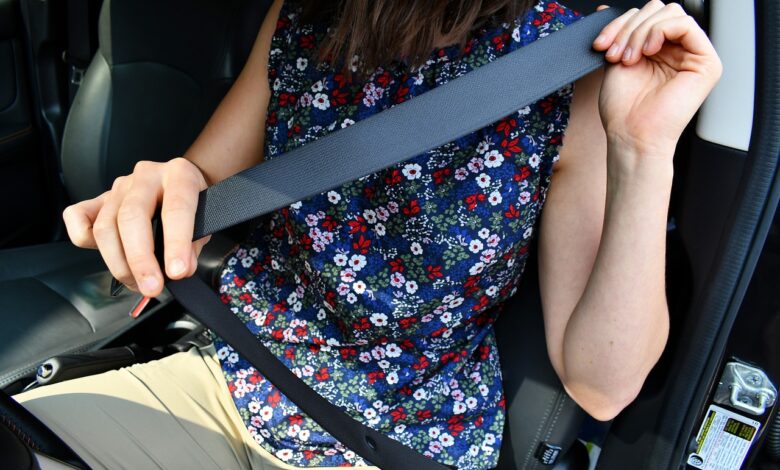Step-By-Step: How to Properly Activate Your Seat Belt for Maximum Safety

Step-by-step instructions are a great way to document and share processes in a standardized manner. Creating these guides can make it easier for employees to understand and follow instructions even when they deviate from them.
The lap belt should be worn low over the hip bones, and the shoulder strap should rest across the chest bone (not behind the back or under the arm). Twisted seat belts can cause serious injuries in a crash.
Buckle Up First
Using caution while driving and buckling up on every trip is an easy way to protect yourself in motor vehicle crashes. It is the number one way to save lives and reduce injuries in a crash, yet millions of Americans do not use seat belts.
Seat belts are designed to spread crash forces across the stronger bony parts of the body, such as the rib cage and shoulder, to minimize injury and death. Seat belts also prevent occupants from being ejected from the vehicle, which is an extremely dangerous event. Occupants who are ejected from vehicles in non-rollover crashes are twice as likely to die, and those ejected from rollover crashes are four times as likely to die.
Your vehicle’s lap and shoulder belts are locked in place by retractors, controlled by sensors that detect abrupt deceleration. These retractors release an explosive charge to drive a piston that quickly spools the webbing, which instantly removes all slack and helps keep you secure in a crash.
Be sure your retractors are fully extended when activating the seat belt. If they are not, they will be sagging and may cause discomfort or restrict your movement while driving. You should also ensure your shoulder belt is positioned directly over your shoulders, not under your arm or slipping off your neck.
Make Sure Your Seat Is Properly Fastened
Car seat safety is about properly fastening your child into their seat. When a seat belt is loose, it’s not doing its job, and your child could be at risk of being ejected from the vehicle or seriously injured in a crash.
Before you buckle up, make sure the seat belt chest clip is at or above shoulder level and that the shoulder straps are snug with no slack. If you can pinch any excess strap webbing together between your fingers, it’s too loose. A loose seat belt can slip off a child’s shoulders during a crash, possibly causing serious injury to the head and neck.
Also, test the seat belt pre-tensioners by pulling out the entire length of the shoulder belt and letting it retract. It should lock automatically, and you’ll hear a distinct “click.” If this feature isn’t activated, it can’t work to keep the driver and passenger in place during a crash.
Also, be sure the lower anchor webbing is routed through the correct belt path. If the anchor isn’t properly routed, it could inflate during a crash and hit your child’s stomach or neck, possibly causing serious injury. Also, never attach any items to the shoulder anchor or buckle not approved by the car seat manufacturer for use with that specific seat.
Remove Any Slack
A seat belt with too much slack can strain the body in a collision, reducing occupant protection. Make sure that you are wearing the lap belt snugly across your hips and pelvic bone and the shoulder strap over your chest, not your neck (which can result in serious injury or death).
Turn on the seat belt locking mechanism if you’ve gotten the webbing as tight as possible without making it uncomfortable. This button is usually located on the shoulder anchor, and pressing it and moving the shoulder anchor up or down will allow you to take out any extra slack. This is a good idea for pregnant women or people with serious medical conditions, as well.
Some vehicles have a feature called the “Emergency Locking Retractor” or “ELR.” To activate this feature, slowly pull on the shoulder belt outside of the car seat shell until you hear a click from the retractor, then feed it back into the vehicle until there is no more slack. You can only do this from the front of the vehicle, not the side where the child restraint is installed.
NEVER contaminate the belt’s components by putting anything into the buckle or ring, such as a purse or wallet. This can cause the device to malfunction and may lead to injuries in a crash. In addition, you should never use any after-market comfort or convenience products attached to the seat belt.
Don’t Forget the Rear Seat
The rear seat is the safest place for children to ride in a vehicle. Rear-facing car seats are designed to prevent a child’s head from striking the front windshield in the event of a crash. However, this does not protect the child from being ejected from the vehicle. The rear seat occupant should be seated upright, with the shoulder belt secured across the chest at armpit level. A slack in the shoulder belt is dangerous as it can rest against the neck and could cause strangulation in the case of an accident.
A startling number of children die each year as a result of being left in the back seat of a vehicle. To combat this problem, some automakers offer a feature called Rear Seat Reminder. This system alerts the driver as they switch off their vehicle that a child (or pets) is in the back seat.
To turn off the reminder:
- Touch the associated seat icon on the popup message. Once the reminder is disabled, the icon will disappear from the message.
- If you’re driving a new vehicle that features this technology, check the owner’s manual for additional information on how to use Rear Seat Reminder correctly.
- Make a habit of always checking the back seat before entering your vehicle.



